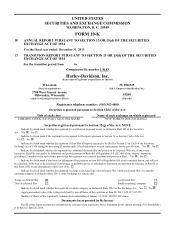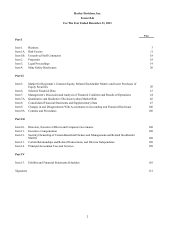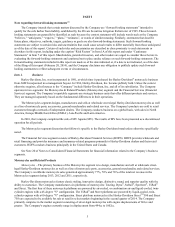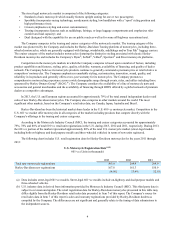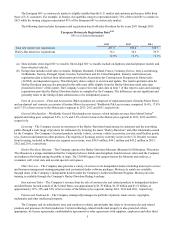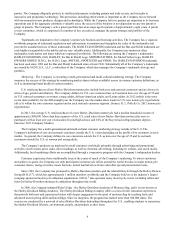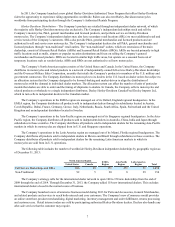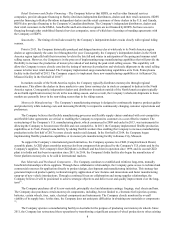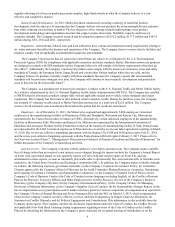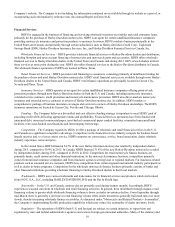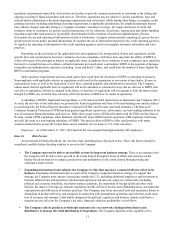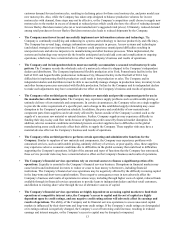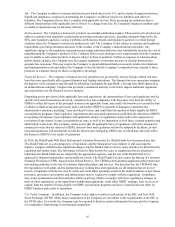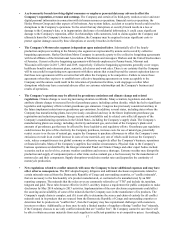Harley Davidson 2013 Annual Report Download - page 9
Download and view the complete annual report
Please find page 9 of the 2013 Harley Davidson annual report below. You can navigate through the pages in the report by either clicking on the pages listed below, or by using the keyword search tool below to find specific information within the annual report.9
suppliers allowing it to focus on producing certain complex, high-finish wheels in what the Company believes is a cost-
effective and competitive manner.
Research and Development – In 2011, Harley-Davidson commenced executing a strategy to transform product
development, with the objective of ensuring that the Company delivers relevant products for an increasingly diverse customer
base while reducing cost and time to market. The key objectives of the strategy include implementing a new product
development methodology and organization structure that support greater innovation, flexibility, capacity and focus on
consumer insights. The Company incurred research and development expenses of $152.2 million, $137.3 million and $145.4
million during 2013, 2012 and 2011, respectively.
Regulation – International, federal, state and local authorities have various environmental control requirements relating to
air, water and noise that affect the business and operations of the Company. The Company strives to ensure that its facilities and
products comply with all applicable environmental regulations and standards.
The Company’s motorcycles that are sold in the United States are subject to certification by the U.S. Environmental
Protection Agency (EPA) for compliance with applicable emissions and noise standards. Harley-Davidson motorcycle products
are designed to comply with EPA standards and the Company believes it will comply with future requirements when they go
into effect(1). Additionally, the Company’s motorcycle products must comply with the motorcycle emissions, noise and safety
standards of Canada, the European Union, Japan, Brazil and certain other foreign markets where they are sold, and the
Company believes its products currently comply with those standards. Because the Company expects that environmental
standards will become more stringent over time, the Company will continue to incur research, development and production
costs in this area for the foreseeable future(1).
The Company, as a manufacturer of motorcycle products, is subject to the U.S. National Traffic and Motor Vehicle Safety
Act, which is administered by the U.S. National Highway Traffic Safety Administration (NHTSA). The Company has certified
to NHTSA that its motorcycle products comply fully with all applicable federal motor vehicle safety standards and related
regulations. The Company has from time to time initiated certain voluntary recalls. During the last three years, the Company
has initiated 16 voluntary recalls related to Harley-Davidson motorcycles at a total cost of $22.0 million. The Company
reserves for all estimated costs associated with recalls in the period that the recalls are announced.
Employees – As of December 31, 2013, the Motorcycles segment had approximately 5,800 employees. Unionized
employees at the manufacturing facilities in Menomonee Falls and Tomahawk, Wisconsin and Kansas City, Missouri are
represented by the United Steelworkers of America (USW). Alternatively, certain unionized employees at the manufacturing
facilities in Menomonee Falls, Wisconsin and Kansas City, Missouri are represented by the International Association of
Machinist and Aerospace Workers (IAM). Production workers at the motorcycle manufacturing facility in York, Pennsylvania
are represented by the IAM. Unionized employees in Wisconsin are covered by seven-year labor agreements expiring on March
31, 2019. The seven-year collective bargaining agreements with the Kansas City USW and IAM unions expire July 31, 2018,
and the seven-year collective bargaining agreement with the Pennsylvania-IAM will expire February 2, 2017. Please refer to
the Overview section of Item 7, “Management’s Discussion and Analysis of Financial Condition and Results of Operations” for
further discussion of the Company’s restructuring activities.
Internet Access – The Company’s internet website address is www.harley-davidson.com. The Company makes available
free of charge (other than an investor’s own internet access charges) through its internet website the Company’s Annual Report
on Form 10-K and related annual review, quarterly reports on Form 10-Q and current reports on Form 8-K, and any
amendments to those reports, as soon as reasonably practicable after it electronically files such material with, or furnishes such
material to, the United States Securities and Exchange Commission (SEC). In addition, the Company makes available, through
its website, the following corporate governance materials: (a) the Company’s Corporate Governance Policy; (b) Committee
Charters approved by the Company’s Board of Directors for the Audit Committee, Human Resources Committee, Nominating
and Corporate Governance Committee and Sustainability Committee; (c) the Company’s Financial Code of Ethics; (d) the
Company’s Code of Business Conduct (the Code of Conduct) in nine languages including English; (e) the Conflict of Interest
Process for Directors, Executive Officers and Other Employees (the Conflict Process); (f) a list of the Company’s Board of
Directors; (g) the Company’s By-laws; (h) the Company’s Environmental Policy; (i) the Company’s Policy for Managing
Disclosure of Material Information; (j) the Company’s Supplier Code of Conduct; (k) the Sustainability Strategy Report; (l) the
list of compensation survey participants used as market reference points for various components of compensation as reported in
the Company’s Notice of Annual Meeting and Proxy Statement filed with the SEC on March 15, 2013, which compensation
relates to the Company’s named executive officers; (m) the California Transparency in Supply Chain Act Disclosure; (n)
Statement on Conflict Minerals; and (o) Political Engagement and Contributions. This information is also available from the
Company upon request. The Company satisfies the disclosure requirements under the Code of Conduct, the Conflict Process
and applicable New York Stock Exchange listing requirements regarding waivers of the Code of Conduct or the Conflict
Process by disclosing the information in the Company’s proxy statement for its annual meeting of shareholders or on the

